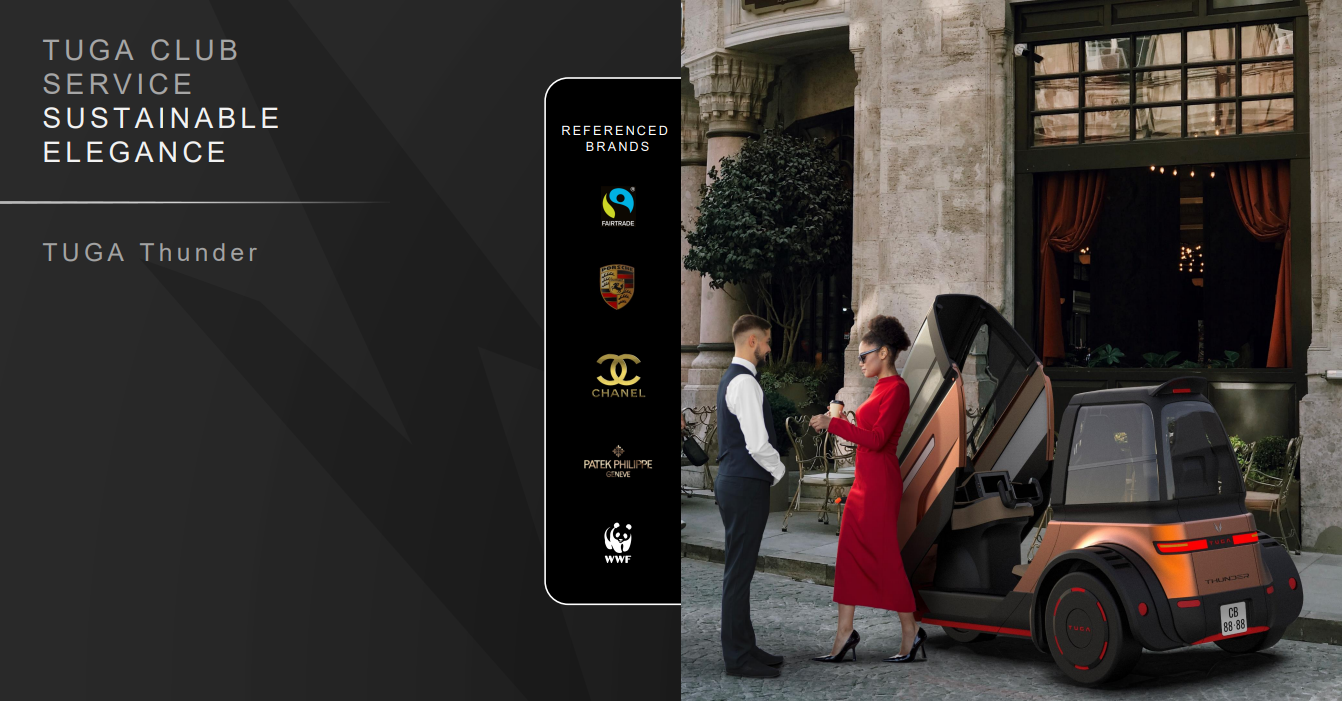The second prototype of the Portuguese TUGA vehicle is scheduled for the beginning of 2024, but the pre-production phase of the first commercial units will not happen before 2025. The Portuguese company wants to launch an innovative subscription service for passengers looking for a premium experience.
It started out as a model vehicle and the idea was that, from a three-wheel chassis, it would be possible to transform it into a convertible, a commercial goods vehicle or a conventional motorcycle. Since it was announced in early 2022, plans for the TUGA have already changed and two models are currently planned, the Commuter and the sporty convertible Thunder.
SAPO TEK visited the company’s headquarters in Cascais to see the first TUGA prototype and meet the company’s co-founder César Barbosa and CEO John Hagie, who explained TUGA Innovations’ vision for the future of mobility, whose tagline is “The Speed of Time”.
“Cesar is the true father of the whole project, he is an architect who worked on a large urban mobility project in Brazil and is a car enthusiast, with a collection of classic models”, that is how the company’s CEO introduced his mentor César Barbosa on our visit.
See photos of the first TUGA prototype that is at the headquarters in Cascais:
In the presentation of the team composed of almost 20 people, John Hagie highlights the presence of António Câmara and Edmundo Nobre, co-founders of Ydreams, for their great experience in technology, which César Barbosa says he has known for almost 30 years: “Do you want to participate in this project? Bring your 30 or 40 years of experience to do something disruptive”, reinforces the company’s co-founder in the invitation. And it was also in previous projects that he met John Hagie, with a connection to HP, who he invited to assume the position of CEO. “We just had a meeting of another side project and I received the invitation to join TUGA”, said John Hagie.
César Barbosa highlights the multidisciplinary capacity of the company’s CEO as essential for the project, in the ability to put his knowledge to work. The advisory board also includes names like Fernando Pinto, former TAP administrator, CFO Faizaan Lalani is in Vancouver and Sultan Seborro is looking for funding for the project in the Middle East.
The engineering leader is Samuel Gomez, Brazilian, who lives in Spain, in Asturias, who in the past worked with Rubens Barrichello in his Formula 1 team, as well as for General Motors and Volkswagen. Before joining the team he worked on a European electric mobility project. Another highlighted team member is Lucas Leonardi, who implemented a program in Paris called “Freedom to Move” and a specialist in “Mobility as a service”, which is one of the company’s strategies to enter the market.

“This is no longer an electric vehicle”, emphasizes César Barbosa. The company started by designing solutions to existing problems, in this case about mobility. John Hagie, who hails from Sales at HP, points out the huge differences between selling IT hardware and an IT solution. “There is a difference between the conversations we have, about solutions we are looking for, which are very different from someone saying they have an interesting new electric vehicle.” The company’s leader says that people need products, but they need solutions for their lives even more.
Its tagline “The Speed of Time” is related to the difficulties in urban transport and “the incredible amount of time people spend in traffic queues, the lost time and the associated environmental and health issues, as well as the economic impact . And we present a solution for that, which is a vehicle that has a unique design and is inspired by motorcycles, which are the only ones capable of cutting through traffic queues”, explains the company’s CEO, reinforcing that both drive three-wheeled motorcycles on their everyday. They point out that the time lost in traffic queues could be used to do many other things, such as spending more time with the family.
The TUGA measures 88 cm, roughly the width of a motorcycle, capable of cutting through traffic. In a curious photograph shown at the presentation, it is seen that practically all stopped cars have only the driver on board, which for the company is a waste. A motorcycle passes between the rows and, of course, a TUGA.
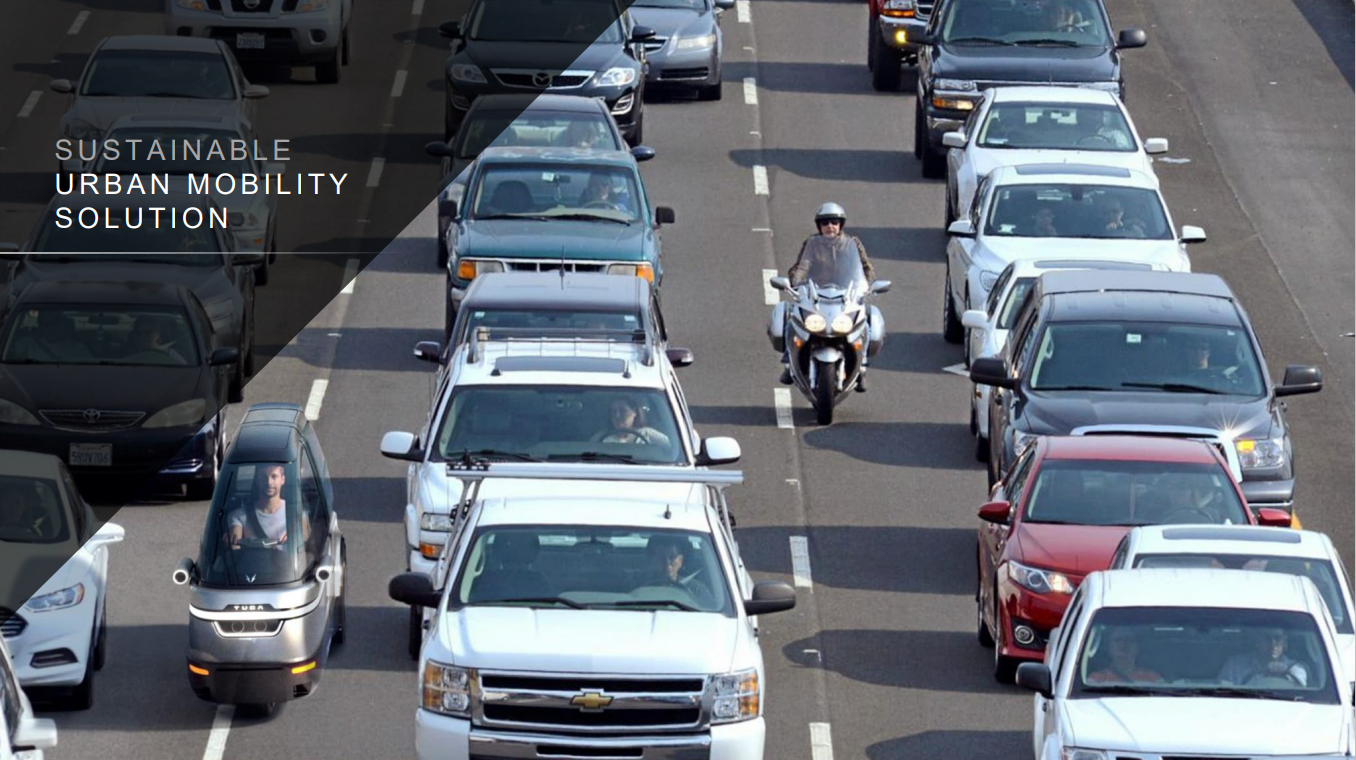
The company explains that the vehicle is an important part of the solution, although elements such as software, data and proprietary technology are also involved. According to John Hagie, there is great concern in building a great brand, with a strong communication image. But why the name TUGA for the project and how was it received across borders? “Out there it is seen as a big name”, said César Barbosa, adding that the sound of the word is strong, “but also because it is the seal of nationality”, highlighting the birthplace of the vehicle in Portugal. The company’s founder reinforces that the TUGA is not a car, “for that it would have to have four wheels and it only has three”.
A secret confided by César Barbosa to SAPO TEK is that TUGA also means “Urban Transport of Great Autonomy”. When the name was registered, the National Institute of Industrial Property (INPI) did not allow the name to be registered precisely because of the Portuguese national connotation. “I spoke with the lawyers, because I wanted the name TUGA for our vehicle, and I asked if I could put points, as if they were initials and that was allowed”. And so the TUGA brand was born for the Portuguese vehicle. The logo was created by the creative director of Ridley Scott Media Group, “John Filipe, who happens to be Portuguese”.
One of the clarifications made during our visit is that the company is not interested in exploring and competing in the “mass market”, where Fiat Panda vehicles, an entry-level smartphone or smartwatch are found. And he is not interested in the premium market of the BMW Series 3 or an upper mid-range watch either. The company wants to place the TUGA Commuter among Deluxe products, such as a Jaguar or a Rolex, with its services. Going up one more floor in the pyramid is the TUGA Thunder, in a subscription service, alongside products from Chanel, Aston Martin or Porsche. And it is at the tip of the pyramid that TUGA sales enter, in the field of exclusives, where there are the Lamborghini Veneno, a Bugatti LA Voiture Noire or a Harley-Davidson Blue Edition.
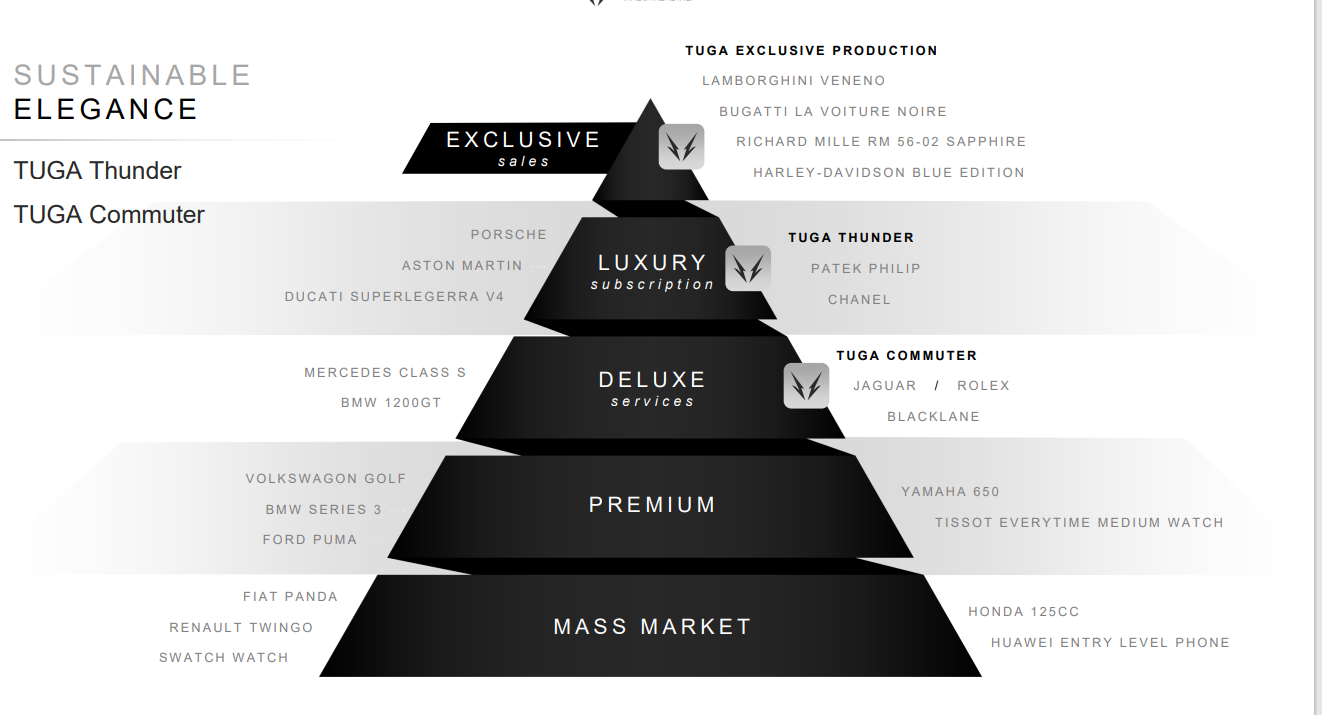
To explain this pyramid, TUGA’s priority is not to sell units. Exclusive sales will be for customers who want their vehicles highly customized. They serve mainly to help promote the brand, being included in the price of around 60 thousand euros. The main objective is for users to subscribe to the luxury mobility services offered by the TUGA Commuter or subscribe to the subscription with Thunder, which still have no price.
The subscription service works as a kind of renting, together with the upgrades that the company is preparing: users pay a monthly fee and have the TUGA Thunder in their garage to use as they wish. Where the company intends to differentiate itself is that if they have to travel to another city or even country, they can be sure that they have a TUGA available to use, without having to take “their own”.
To this end, it intends to license a franchising system and create an increasingly wide network in the allocation of vehicles. The company wants to include a valet system in the service, in which someone goes to meet the customer to deliver the vehicle. “It’s like a kind of club”, in César Barbosa’s vision of what he wants for his services.
Services that the company calls “Sustainable Elegance”, for an audience that appreciates innovation and sustainability. TUGA Innovations claims that there are not many products of this kind in this luxury segment and that is why its image is very clear. And he has no problem saying that his product will be expensive when it hits the market. “If you want to do well and do something robust, structured and top technology, etc. and if you want to do it cheaply, you die”, said César Barbosa. That would put the company in competition with Chinese or Indian electric cars. “It’s mass production, low profits and a big fight. It’s easier to go to the bridge over the Tagus and dive in ”, he adds with humour.
Even its mobility service intends to raise quality, offering a transport proposal like an Uber or Bolt, but in a luxury segmentation, which the company compares to the German BlackLane. A chauffeur service, where the driver only carries one passenger in the back. If we look at the TVDE vehicles circulating on the roads, a large percentage carry only one person. This is where TUGA intends to stand out. “Uber works for the masses, we intend to offer something more exclusive”, said César Barbosa. The comparison, albeit small, that the company can make about its vision of the services it proposes is the transport of passengers on motorcycles in the streets of Paris.
See in the gallery some conceptual images of the various models initially proposed:
The company highlighted a preliminary conversation with the Chamber of Oeiras, a municipality that has sought to remain at the forefront of technology at national level. And there may be a pilot program for the service in the city in the future. It is not the objective of TUGA Innovations to be present in national municipalities, competing with other mobility systems, as this is not its target audience. “If the mayor of New York calls us, obviously we’ll go there”, says César Barbosa. “We previously sent a request to the Lisbon Chamber and did not even receive a response. But if they see the system implemented in Oeiras, they might become interested” reinforces John Hagie.
The company has not yet defined prices for the subscription or mobility offer. John Hagie says they will look at subscription service models like Porsche and offer 30% less than that for a similar offer. In mobility, it should be within the values of an Uber Black or BlackLane, hoping to be on par with these services.
On the software side, the company offers an augmented reality application for iOS and Android, which for now helps in promoting the vehicle and having more information about it. The models available can be projected onto a table in the living room to observe their functionality. The company also wants to use the application as a social tool, challenging users to show TUGA in the city and other initiatives.
The company intends for TUGA to be integrated into the Smart Cities data exchange networks. The vehicle will collect data during its circulation and transmit it to the local authorities, if they so wish, namely the air quality.
“We have an AI interface for the passenger and the driver. Our services will have the platform and the app. If we are in a city, we can use the TUGA app and ask for transport”, explains the company’s CEO. The driver will have access to information about traffic, road works, parking conditions, timetables relating to transport systems, charging stations, as well as vehicle information and other personalized data. The driver can access information about air quality, both inside the vehicle and outside. There will also be AI-generated content, as well as entertainment, shopping promotions and personalized data. Companies that have a fleet of TUGA vehicles will also have access to information that makes their management easier.
The application will also open several interactions with the vehicle itself, as explained to SAPO TEK. For example, simply slide the steering wheel up and down in the app’s virtual cockpit for this to be reflected in the vehicle, which in this case helps the driver to sit comfortably. Functionalities that are already being introduced in the second prototype that is being finalized.
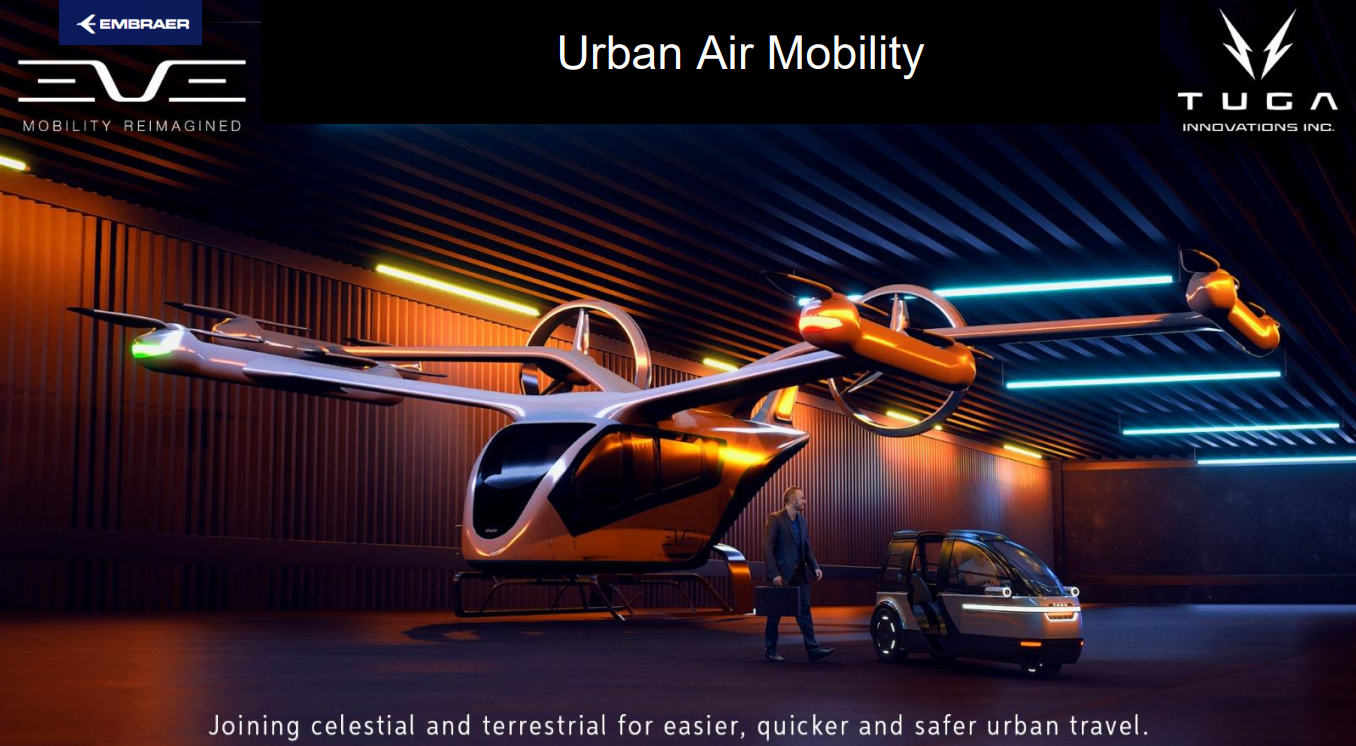
Looking to the not-too-distant future, TUGA wants to be the companion of urban air mobility. The vehicle that will be waiting for the passenger who has just landed from an eVTOL, to quickly transport him to his final destination. Thanks to the expertise of Fernando Pinto, TUGA Innovation has an agreement with Eve Air Mobility, a subsidiary of the Brazilian Embraer, to create an experience for customers of eVTOL services. “No one invests in a quick trip in eVTOL and then gets stuck in traffic to the destination, it makes no sense,” said John Hagie.
Initially it will not offer remote driving, although it may be possible for drivers to park the vehicle from the smartphone, from the outside, as if it were a remote controlled car. The company hopes to implement this system in the next prototype. It should be noted that the dimensions of the TUGA respect motorcycles, which means that it will be able to park five vehicles in the space of a conventional car. The vehicle is very light, built in carbon fiber, and can be parked by hand like a motorcycle.
The company’s objective was to seek to create a vehicle to feed a vision of mobility services that went beyond the spectrum of motorcycles and cars already on the market.
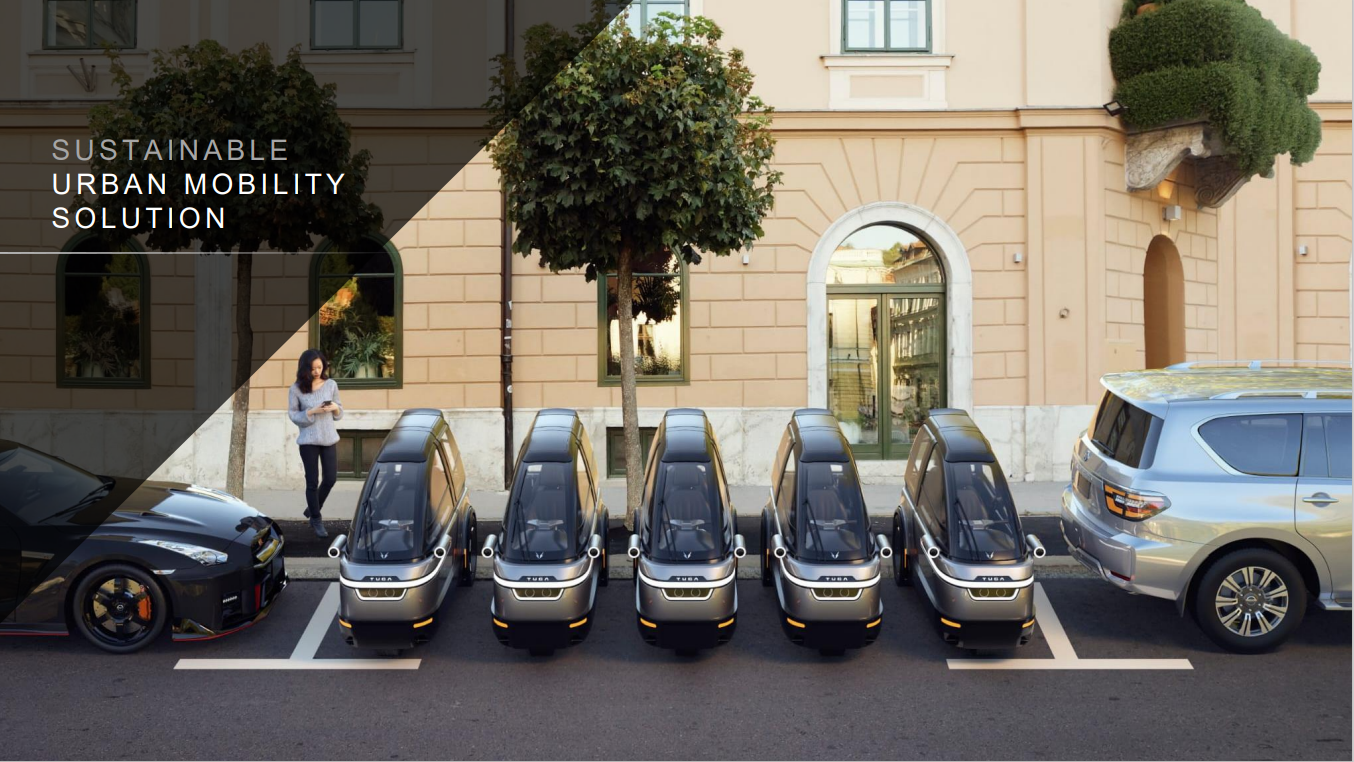
The prototype parked at its headquarters in Cascais will be two years old in December and was designed to transport people from sleeping quarters to the center of the respective cities. The TUGA can be used on the highway and reaches 140 km/h. And it was created for use at any age, from 18 to 88 years old, says the company’s leader, who have a driving license.
The vehicle does not tilt and has a retractable rear axle, resting on an expansive chassis. And with that it promises to be narrow like a motorcycle, but closed and safe like a car. It is 88 centimeters wide and 2.45 meters long, slightly larger than a motorcycle. And with the advantage of having cargo space, an interior air purifier system, drone integration, as well as being fun to drive and easy to park, the company claims.
Looking at the next prototype, the V2, the Thunder model allows you to remove the hood and windshield to transform it into a convertible. The company hopes to launch the vehicle initially in Dubai and the Middle East. In order to segment the brand, it was decided to eliminate the initial proposal for cargo transport versions, as it did not fit the current vision of services. Even so, doors are not closed in the future for an eventual offer, if interested investors appear. And if that happens, it could even be a sub-brand different from TUGA.
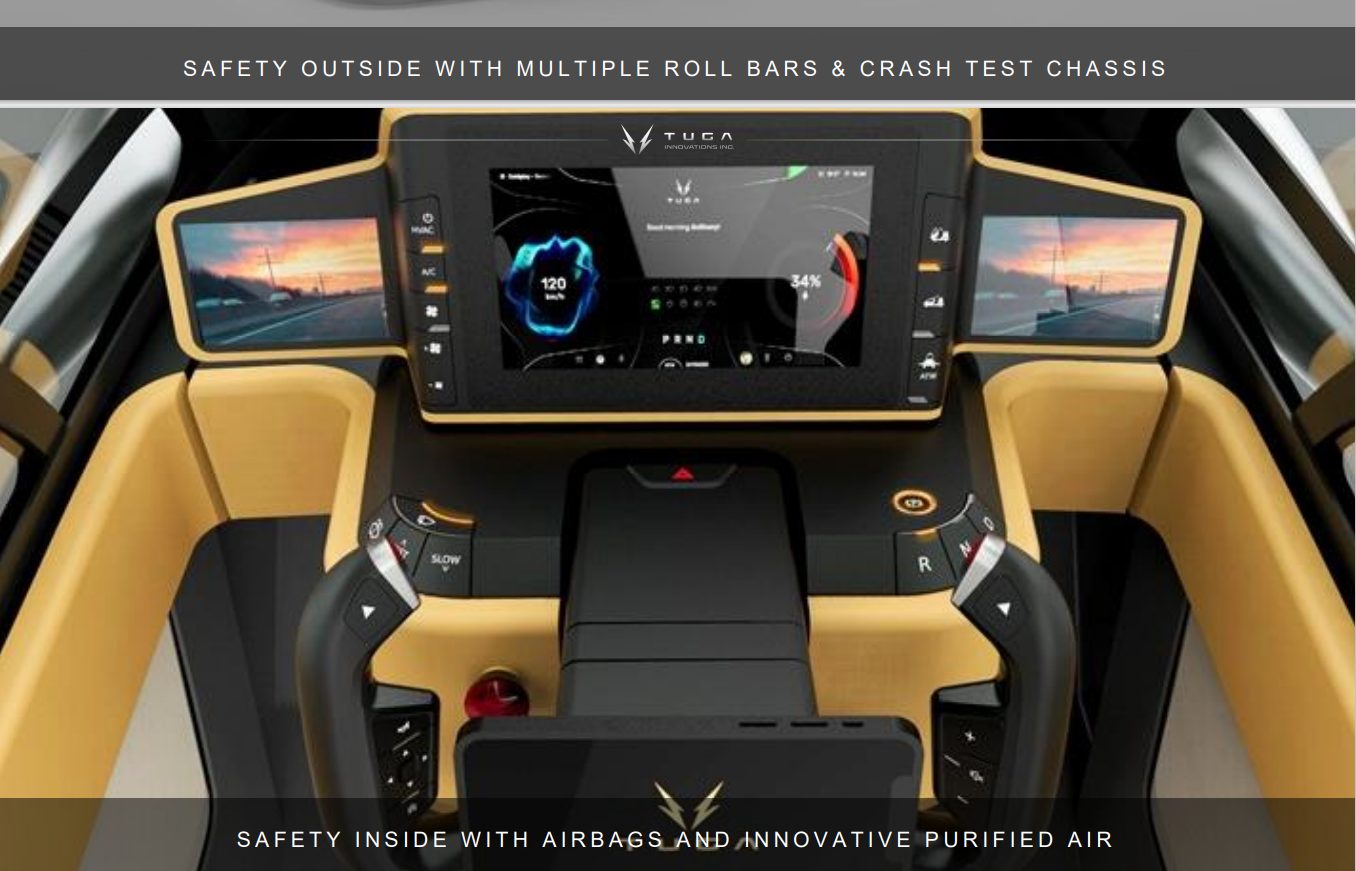
The vehicle has no doors, to get inside, its chassis opens and closes 65 centimeters so that the passenger and the driver can take their seats and it is one of the 19 Patents that TUGA Innovations has registered. The vehicle’s dome tilts, similar to an airplane cockpit. A mechanism that César Barbosa says the engineering work is already done for the next prototype. And the design intends to keep the vehicle safe with three rollbars placed on the TUGA structure. “It’s a safety capsule. It’s small, but very safe.”
César Barbosa mentions that it has not yet gone into production more quickly so that the project can mature and be fine-tuned. “When you run into production, you make several mistakes, which you then try to correct, but you can’t”, he points out. He explains that in Japan there is a culture in which “the brain is put into the project” and gives the example of a hospital, which in the country may take five years to build and three of them are to do the project, with the remaining two for construction. “Here it would be one year for the project and four years to build it”. For you, it is easier to correct a project than a structure.
One aspect explained in the company’s vision concerns the privacy of customers who choose the TUGA mobility service. Despite the reduced dimensions of the vehicle, César Barbosa says that passenger and driver are separated by a fixed division, which gives total privacy to the customer, whether he is working or closing a deal on the phone. The rear windows themselves are tinted to make it difficult to peek into the interior. Communication is done by pressing a button, opening communication between the two parts of the cabin. “Even the air they breathe is different, making it possible to control the temperature of the air conditioning between the driver and passenger”.
The vehicle will have technology to analyze the air quality both inside the vehicle and outside. This was made possible by partnering with a company that has experience in purifying the air in hospital rooms.
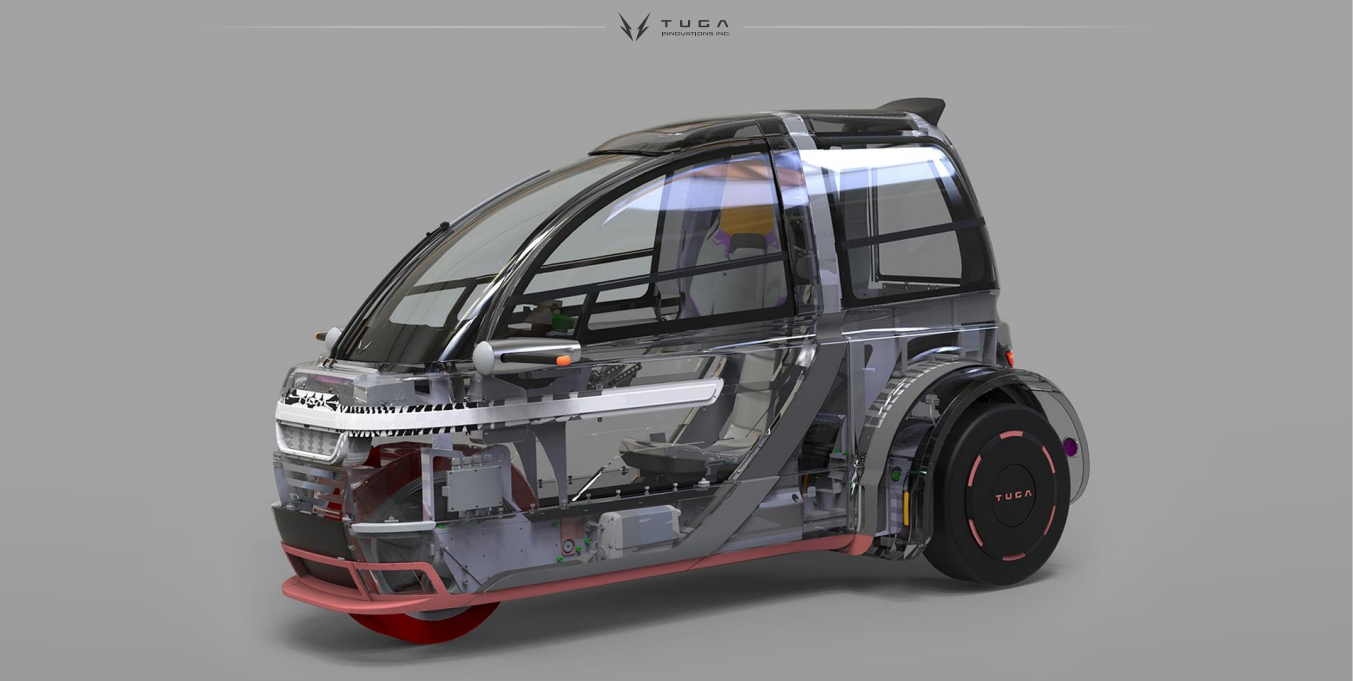
The search to offer a disruptive model in the market, technologically advanced, safe and with a focus on privacy are factors that lead the company to put the price of the vehicle in premium status, well above 50 thousand dollars. And despite comparing the price to a top-of-the-line Harley Davidson, César Barbosa claims that “they don’t have anything we’re offering”. However, as previously mentioned, the sale of vehicles will be personalized and handmade for customers willing to pay the price.
It will not be a vehicle available at the dealership to buy, each customer will make their version with the company. Limited special editions covering general themes will be available. The vehicle will be the basis of the service business that TUGA Innovations intends to explore, although a customer who is satisfied with the experience he has had can take the next step and purchase a personalized model.
It should be noted that TUGA Innovations is part of a consortium together with two other companies. Vangest S.A in Marinha Grande was responsible for manufacturing the first prototype; and Optimal Structural Solutions, a company located in Alcabideche, close to the Estoril race track, provided space for TUGA to open its headquarters. This company creates very light advanced structures for luxury vehicles, Formula 1 and nautical and is also developing for TUGA.
The TUGA V2 has a body designed to fit two people up to 1.90 m inside. Ergonomics was one of the new concerns for this second model, since in the first the objective was to test the vehicle’s concept, validating the width of the rear axle from 1.28 to 0.88 meters. “Up to 0.88 meters is perfect for the vehicle’s agility, from then on each centimeter becomes one meter”, said the project’s mentor. And without agility there is no mobility.
The first vehicle had several adaptations to be ready in time to show investors. The foot positioning area, for example, received several “contraptions” to help the roof close. The second prototype not only grew 17 cm compared to the first, but also saw its rear axle shrink, with the wheels less protruding from the bodywork. Even the motorcycle steering wheel of the first version was just for testing, since the second one will be much more sophisticated.
